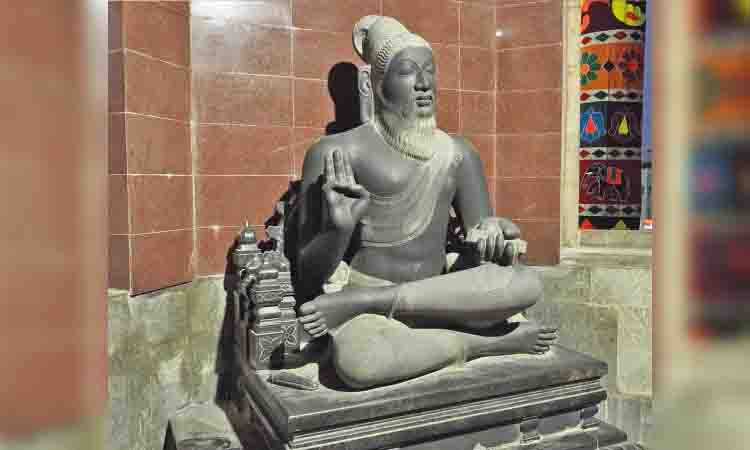Chennai: Of all the Tamil icons celebrated and cherished by all social and political movements in Tamil Nadu, Tiruvalluvar, author of the timeless literature Tirukkural, was perhaps the most revered. Many movements have many icons – Thanthai Periyar for Dravidian movements, Pandit Iyothithasar for Dalit movements and even Tamil nationalists sometimes celebrate slain LTTE chief Prabhakaran. But, the bearded poet, considered an extension of the Sangam era, is undoubtedly an identity that is loved by the atheistic Dravidian movement, theistic saffron movement and mixed Tamil nationalists alike in contemporary Tamil Nadu. Inaugurating the renovated Valluvar Kottam on Saturday, Chief Minister MK Stalin joined the ranks of Periyar, CN Annadurai and Kalaignar M Karunanidhi in immortalising the poet in modern times, perhaps, even more than the Sangam era or the era of later kings. If Periyar organised the first convention of Tirukkural in 1949, the same year Arignar Anna, an admirer of the universality of literature, founded the DMK. Karunanidhi wrote thousands of pages of tireless commentary for the 1,330 couplets before setting up the Valluvar Kottam in 1974-75 and finally installing the 133-feet tall statue in Kanyakumari, which changed the face of the district.
In fact, the racial purists of the Naam Tamilazhar Katchi are now staking exclusive claim to the legacy of that boundless literature, known for its neutrality and universality of ideas, simply because it was written in Tamil. And then came the saffron brigade, led by the state BJP and the current governor RN Ravi, who made a poet wear a pottu, a sacred thread and saffron robes, whose literature shows no trace of any religious sect. The answer to the jealous admiration or appropriation of the 2,000-year-old poet in modern Tamil Nadu lies in his seven-word couplets. Unlike other literature, which depicts social mobility and largely praises the rulers of their times, Tiruvalluvar’s couplets venerated neither a king nor the prevailing faith of the time. In this sense, the Tirukkural is also different from Tamil classics such as the Naladiyar and Silapathikaram, which were alleged to be adorned with marks of hierarchical inequality. A., former professor of history and convener of the Save History Movement, said: Karunanandan says: “The stories weaved around Tiruvalluvar are fictions, invented later by individuals who saw him through their own lens. Critical evaluation of Tiruvalluvar should be done on the basis of Tirukkural and not on the basis of claims made by others. People like Parimel Alagar wrote commentaries later and imposed the prejudices of their times. Tirukkural is a literature that preaches universal morality. It should be viewed independently.”
He mentions the wig-wearing king (Karikala Pervulathan) in Naladiyar who talks of passing judgements in consultation with a select few in his court. “Similarly, the story of Nedunchezhia Pandian in Silapathikaram is no different. He killed Kovalan, a merchant, without a fair trial. Most of the moral preaching literature of the time had traces of varnashram and justified the acts of rulers of the ages. But, Tirukkural does not specify any land or king,” he explained. “Thiruvalluvar had the intellectual maturity to talk about politics and morality without any prejudice and hatred towards anyone.” V Arasu, a retired Tamil professor from Madras University, said that between 1 BC and 5-6 AD, Buddhism and Jainism flourished, and Vedic religion was not popular at that time. “Thirukkural, which is an extension of Sangam literature, gave priority to humanity. Sanskrit had a mythological background, but Tirukkural was practical and did not use mythology. It was neutral and secular. It can be accepted by everyone at all times, and it is relevant even today,” he said. “Manusmriti cannot be applied contemporaneously, but Tirukkural is beyond boundaries. Since it is in Tamil, and such values were upheld 2,000 years ago, we need to celebrate it. Every literature around the world will have some religious affiliation. Tirukkural has none.” Professor Suba Veerapandian of the Dravida Iyakka Tamizhar Peravai said it is natural for any literary work to reflect its age. “Very few literary works challenge their age; it takes some courage to do so. For example, Sangam literature included the consumption of meat and toddy. Even Avvaiyar has sung verses on drinking alcohol with the king, but Tirukkural opposed it,” he said.
